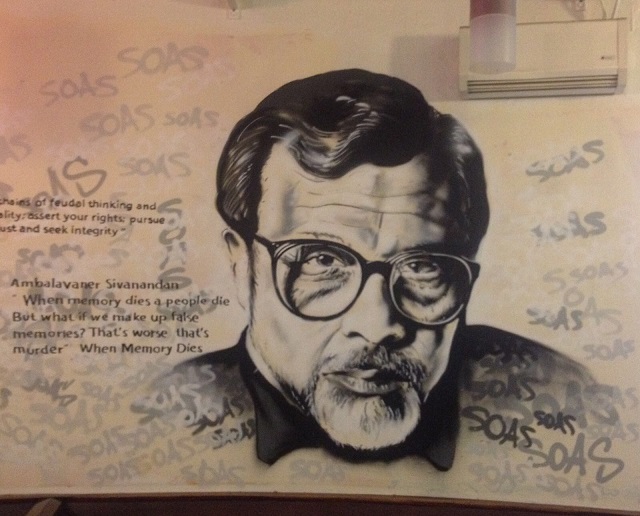by VIROU SRILANGARAJAH

A. Sivanandan, who passed away last month, was one of Britain’s foremost and most influential thinkers on race, class and power. Virou Srilangarajah pays tribute to a remarkable life, and a towering intellectual and political legacy.
“That he was still alive at the time, though in comparative retirement, makes that neglect even sadder.” So wrote Ambalavaner Sivanandan in 1980, commenting on the lack of acknowledgement by black political movements of the 1960s in the United States of the immense contribution and influence of Paul Robeson. Sivanandan pointed out that although they rightly honoured Martin Luther King and Malcolm X, they failed to acknowledge the struggles and sacrifices of Robeson that preceded them.
These words echo the sentiment felt by activists, scholars and communities involved in the anti-racist movement in Britain with the recent passing of A. Sivanandan* himself, whose neglect by today’s generation is both disappointing and shameful. He was, for four decades, the Director of the Institute of Race Relations (IRR), and the founding editor of its journal Race & Class, which has had contributions from the likes of Noam Chomsky, Edward Said, Walter Rodney, Aijaz Ahmad, Chris Searle, Manning Marable, Cedric Robinson, Ilan Pappe, Basil Davidson, John Berger, Eqbal Ahmad, Angela Davis and John Newsinger.
Sivanandan was in a class of his own as a thinker, writer and speaker. His deliberations on the issues of racism, immigration, capitalism and imperialism were a particular beacon of hope for activists and communities during the bleak Thatcher years of the 1980s. He was a visionary whose insights were original and whose ideas still remain relevant today, yet his name – with few honourable exceptions – is seldom, if ever, cited by the British left. Simply put, Sivanandan’s influence upon those involved in the anti-racist movement – whether they are aware of it or not – is monumental.
Sivanandan was very conscious of how racism evolved – especially with changes in the economy and how reduced demand for labour consequently affected immigration policy. His landmark 1976 essay Race, Class and the State was the first serious and radical explanation of the political economy of race and immigration in post-World War Two Britain, and set the benchmark for all future analysis.
Over the years he documented and explained the ‘rationale’ for the racism that was weaponised by the state and the popular press against black peoples (using the term in the political sense; i.e. those deemed outside of ‘whiteness’), including refugees, asylum seekers and migrant workers. There was, according to Sivanandan, “The racism that discriminates and the racism that kills.” He mostly concerned himself with the latter, focusing on its primary victims: the working class and those catching hell on the streets, rather than the middle-class woes of well-to-do ethnic minorities.
Often mischaracterised by the liberal-left, bourgeois academics and middle-class minorities alike as an out-dated relic from the past, it was clear to anyone who read and reflected upon Sivanandan’s writings or listened to him speak that, in fact, it was they who were being left behind by reality – a failure to ‘catch history on the wing’, as he put it. Take, for example, the continued inability of some elements of the left to incorporate race into their analysis of class. The latest and most notable illustration of this is the ‘Lexit’ brigade, who (mis) calculated that they could hijack the ‘Brexit’ narrative from the long-term clutches of the right – a mouse riding the back of a tiger, as one commentator astutely put it.
Cease Fire for more
